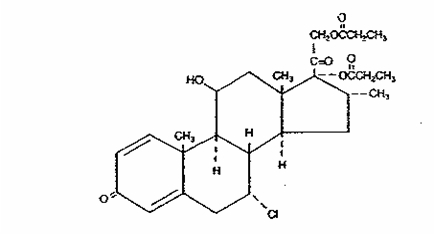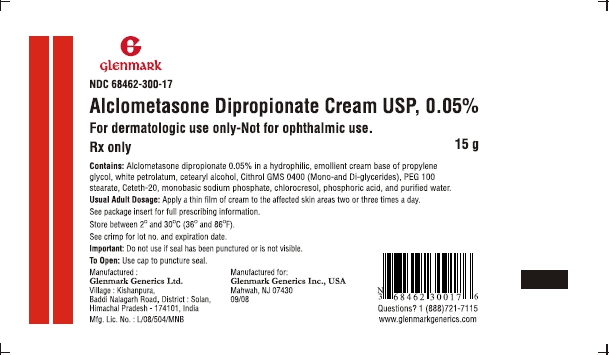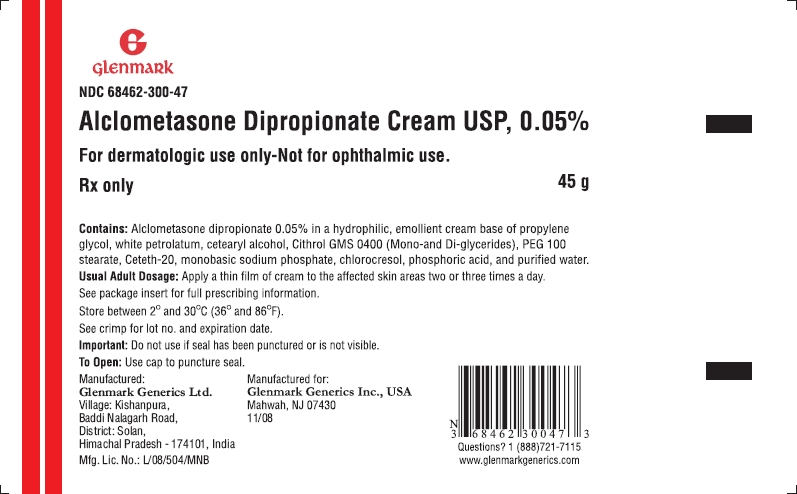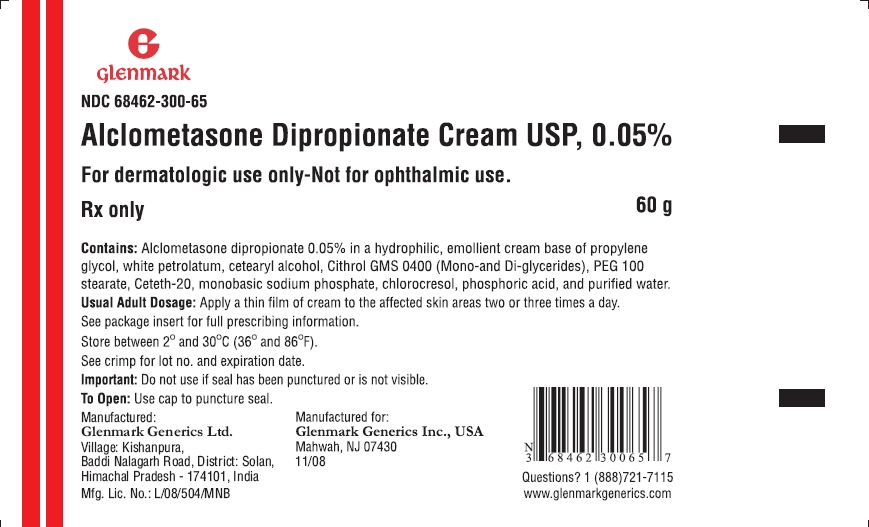ALCLOMETASONE DIPROPIONATE
-
alclometasone dipropionate cream
Glenmark Generics Inc., USA
----------
Alclometasone Dipropionate Cream USP, 0.05%Prescribing Information
For Dermatologic Use Only -
Not for Ophthalmic Use.
DESCRIPTION
Alclometasone dipropionate cream USP, 0.05% contains alclometasone dipropionate (7 α-chloro-11β,17,21-trihydroxy-16 α-methylpregna-1,4-diene-3,20-dione 17,21-dipropionate), a synthetic corticosteroid for topical dermatologic use. The corticosteroids constitute a class of primarily synthetic steroids used topically as anti-inflammatory and antipruritic agents.
Chemically, alclometasone dipropionate is C28H37ClO7. It has the following structural formula:

Alclometasone dipropionate has the molecular weight of 521. It is a white powder, insoluble in water, slightly soluble in propylene glycol, and moderately soluble in hexylene glycol.
Each gram of alclometasone dipropionate cream contains 0.5 mg of alclometasone dipropionate in a hydrophilic, emollient cream base of propylene glycol, white petrolatum, cetearyl alcohol, Cithrol GMS 0400 (Mono- and Di-glycerides), PEG 100 stearate, Ceteth-20, monobasic sodium phosphate, chlorocresol, phosphoric acid, and purified water.
CLINICAL PHARMACOLOGY
Like other topical corticosteroids, alclometasone dipropionate has anti-inflammatory, antipruritic, and vasoconstrictive properties. The mechanism of the anti-inflammatory activity of the topical steroids, in general, is unclear. However, corticosteroids are thought to act by the induction of phospholipase A2 inhibitory proteins, collectively called lipocortins. It is postulated that these proteins control the biosynthesis of potent mediators of inflammation such as prostaglandins and leukotrienes by inhibiting the release of their common precursor, arachidonic acid. Arachidonic acid is released from membrane phospholipids by phospholipase A2.
Pharmacokinetics
The extent of percutaneous absorption of topical corticosteroids is determined by many factors, including the vehicle and the integrity of the epidermal barrier. Occlusive dressings with hydrocortisone for up to 24 hours have not been demonstrated to increase penetration; however, occlusion of hydrocortisone for 96 hours markedly enhances penetration. Topical corticosteroids can be absorbed from normal intact skin. Inflammation and/or other disease processes in the skin may increase percutaneous absorption.
Studies performed with alclometasone dipropionate cream indicate that this product is in the low to medium range of potency as compared with other topical corticosteroids.
INDICATIONS AND USAGE
Alclometasone dipropionate cream is a low to medium potency corticosteroid indicated for the relief of the inflammatory and pruritic manifestations of corticosteroid-responsive dermatoses. Alclometasone dipropionate cream may be used in pediatric patients 1 year of age or older, although the safety and efficacy of drug use for longer than 3 weeks has not been established (see PRECAUTIONS: Pediatric use). Since the safety and efficacy of alclometasone dipropionate cream have not been established in pediatric patients below 1 year of age, their use in this age-group is not recommended.
CONTRAINDICATIONS
Alclometasone dipropionate cream is contraindicated in those patients with a history of hypersensitivity to any of the components in these preparations.
PRECAUTIONS
General
Systemic absorption of topical corticosteroids can produce reversible hypothalamic-pituitary-adrenal (HPA) axis suppression with the potential for glucocorticosteroid insufficiency after withdrawal of treatment. Manifestations of Cushing syndrome, hyperglycemia, and glucosuria can also be produced in some patients by systemic absorption of topical corticosteroids while on treatment.
Patients applying a topical steroid to a large surface area or to areas under occlusion should be evaluated periodically for evidence of HPA axis suppression. This may be done by using the ACTH stimulation, A.M. plasma cortisol, and urinary free cortisol tests.
The effects of alclometasone dipropionate cream on the HPA axis have been evaluated. In one study, alclometasone dipropionate cream was applied to 30% of the body twice daily for 7 days, and occlusive dressings were used in selected patients either 12 hours or 24 hours daily. In another study, alclometasone dipropionate cream was applied to 80% of the body surface of normal subjects twice daily for 21 days with daily 12-hour periods of whole body occlusion. Average plasma and urinary free cortisol levels and urinary levels of 17-hydroxysteroids were decreased (about 10%), suggesting suppression of the HPA axis under these conditions. Plasma cortisol levels have also been demonstrated to decrease in pediatric patients treated twice daily for 3 weeks without occlusion.
If HPA axis suppression is noted, an attempt should be made to withdraw the drug, to reduce the frequency of application, or to substitute a less potent corticosteroid. Recovery of HPA axis function is generally prompt upon discontinuation of topical corticosteroids. Infrequently, signs and symptoms of glucocorticosteroid insufficiency may occur, requiring supplemental systemic corticosteroids. For information on systemic supplementation, see prescribing information for those products.
Pediatric patients may be more susceptible to systemic toxicity from equivalent doses due to their larger skin surface area to body mass ratios (see PRECAUTIONS: Pediatric use).
If irritation develops, alclometasone dipropionate cream should be discontinued and appropriate therapy instituted. Allergic contact dermatitis with corticosteroids is usually diagnosed by observing a failure to heal rather than noting a clinical exacerbation, as with most topical products not containing corticosteroids. Such an observation should be corroborated with appropriate diagnostic patch testing.
If concomitant skin infections are present or develop, an appropriate antifungal or antibacterial agent should be used. If a favorable response does not occur promptly, use of alclometasone dipropionate cream should be discontinued until the infection has been adequately controlled.
Information for patients
Patients using topical corticosteroids should receive the following information and instructions:
- This medication is to be used as directed by the physician. It is for external use only. Avoid contact with the eyes.
- This medication should not be used for any disorder other than that for which it was prescribed.
- The treated skin area should not be bandaged, otherwise covered or wrapped so as to be occlusive, unless directed by the physician.
- Patients should report to their physician any signs of local adverse reactions.
- Parents of pediatric patients should be advised not to use alclometasone dipropionate cream in the treatment of diaper dermatitis. Alclometasone dipropionate cream should not be applied in the diaper area as diapers or plastic pants may constitute occlusive dressing (see DOSAGE AND ADMINISTRATION).
- This medication should not be used on the face, underarms, or groin areas unless directed by the physician.
- As with other corticosteroids, therapy should be discontinued when control is achieved. If no improvement is seen within 2 weeks, contact the physician.
Laboratory tests
The following tests may be helpful in evaluating patients for HPA axis suppression:
ACTH stimulation test
A.M. plasma cortisol test
Urinary free cortisol test
Carcinogenesis, mutagenesis, impairment of fertility
Long-term animal studies have not been performed to evaluate the carcinogenic potential or the effect on fertility of topical corticosteroids.
Pregnancy
Teratogenic effects
Pregnancy Category C
Corticosteroids have been shown to be teratogenic in laboratory animals when administered systemically at relatively low dosage levels. Some corticosteroids have been shown to be teratogenic after dermal application in laboratory animals. There are no adequate and well-controlled studies in pregnant women. Alclometasone dipropionate cream should be used during pregnancy only if the potential benefit justifies the potential risk to the fetus.
Nursing mothers
Systemically administered corticosteroids appear in human milk and could suppress growth, interfere with endogenous corticosteroid production, or cause other untoward effects. It is not known whether topical administration of topical corticosteroids could result in sufficient systemic absorption to produce detectable quantities in human milk. Because many drugs are excreted in human milk, caution should be exercised when alclometasone dipropionate cream is administered to a nursing woman.
Pediatric use
Alclometasone dipropionate cream may be used with caution in pediatric patients 1 year of age or older, although the safety and efficacy of drug use for longer than 3 weeks have not been established. Use of alclometasone dipropionate cream is supported by results from adequate and well-controlled studies in pediatric patients with corticosteroid-responsive dermatoses. Since the safety and efficacy of alclometasone dipropionate cream has not been established in pediatric patients below 1 year of age, its use in this age-group is not recommended. Because of a higher ratio of skin surface area to body mass, pediatric patients are at a greater risk than adults of HPA axis suppression and Cushing syndrome when they are treated with topical corticosteroids. They are therefore also at a greater risk of adrenal insufficiency during and/or after withdrawal of treatment. Adverse effects, including striae have been reported with inappropriate use of topical corticosteroids in infants and children. Pediatric patients applying alclometasone dipropionate cream to > 20% of the body surface area are at higher risk for HPA axis suppression.
HPA axis suppression, Cushing syndrome, linear growth retardation, delayed weight gain, and intracranial hypertension have been reported in pediatric patients receiving topical corticosteroids. Manifestations of adrenal suppression in pediatric patients include low plasma cortisol levels and absence of response to ACTH stimulation. Manifestations of intracranial hypertension include bulging fontanelles, headaches, and bilateral papilledema.
Alclometasone dipropionate cream should not be used in the treatment of diaper dermatitis.
Geriatric use
Clinical studies of alclometasone dipropionate cream in US clinical trials did not include sufficient numbers of subjects aged 65 and over to determine whether they respond differently from younger subjects. Other reported clinical experience has not identified differences in responses between the elderly and younger patients. In general, dose selection for an elderly patient should be cautious.
ADVERSE REACTIONS
The following local adverse reactions have been reported with alclometasone dipropionate cream in approximately 2% of patients: itching and burning, erythema, dryness, irritation, and popular rashes.
The following additional local adverse reactions have been reported infrequently with topical corticosteroids, but may occur more frequently with the use of occlusive dressings. These reactions are listed in approximate decreasing order of occurrence: folliculitis, acneiform eruptions, hypopigmentation, perioral dermatitis, allergic contact dermatitis, secondary infection, skin atrophy, striae, and malaria.
OVERDOSAGE
Topically applied alclometasone dipropionate cream can be absorbed in sufficient amounts to produce systemic effects (see PRECAUTIONS).
DOSAGE AND ADMINISTRATION
Apply a thin film of alclometasone dipropionate cream to the affected skin areas 2 or 3 times daily; massage gently until the medication disappears.
Alclometasone dipropionate cream may be used in pediatric patients 1 year of age or older. Safety and effectiveness of alclometasone dipropionate cream in pediatric patients for more than 3 weeks of use has not been established. Use in pediatric patients under 1 year of age is not recommended.
As with other corticosteroids, therapy should be discontinued when control is achieved. If no improvement is seen within 2 weeks, reassessment of diagnosis may be necessary.
Alclometasone dipropionate cream should not be used with occlusive dressings unless directed by a physician. Alclometasone dipropionate cream should not be applied in the diaper area if the child still requires diapers or plastic pants as these garments may constitute occlusive dressing.
HOW SUPPLIED
Alclometasone dipropionate cream USP, 0.05% is supplied in:
15-g tubes (NDC 68462-300-17)
45-g tubes (NDC 68462-300-47)
60-g tubes (NDC 68462-300-65
Store between 2o and 30oC (36o and 86oF).
Manufactured:
Glenmark Generics Ltd.
Village: Kishanpura, Baddi Nalagarh Road
District: Solan, Himachal Pradesh – 174101, India
Manufactured for:

Glenmark Generics Inc., USA
Mahwah, NJ 07430
Questions? 1 (888)721-7115
www.glenmarkgenerics.com
November 2008
PRINCIPLE DISPLAY PANEL



| ALCLOMETASONE DIPROPIONATE
alclometasone dipropionate cream |
|||||||||||||||||||||
|
|||||||||||||||||||||
|
|||||||||||||||||||||
|
|||||||||||||||||||||
|
|||||||||||||||||||||
|
|||||||||||||||||||||
| Marketing Information | |||
| Marketing Category | Application Number or Monograph Citation | Marketing Start Date | Marketing End Date |
| ANDA | ANDA079061 | 06/23/2009 | |
| Labeler - Glenmark Generics Inc., USA (835917282) |
| Establishment | |||
| Name | Address | ID/FEI | Operations |
| Glenmark Generics Limited | 676115028 | ANALYSIS, MANUFACTURE | |